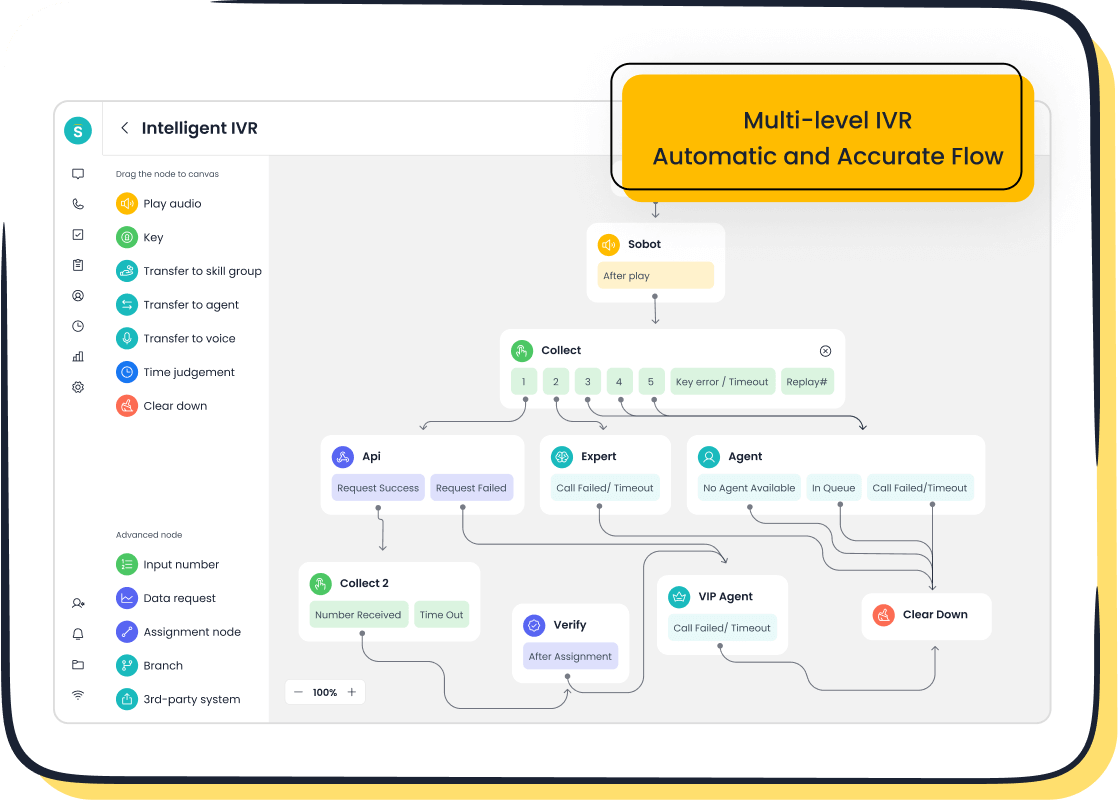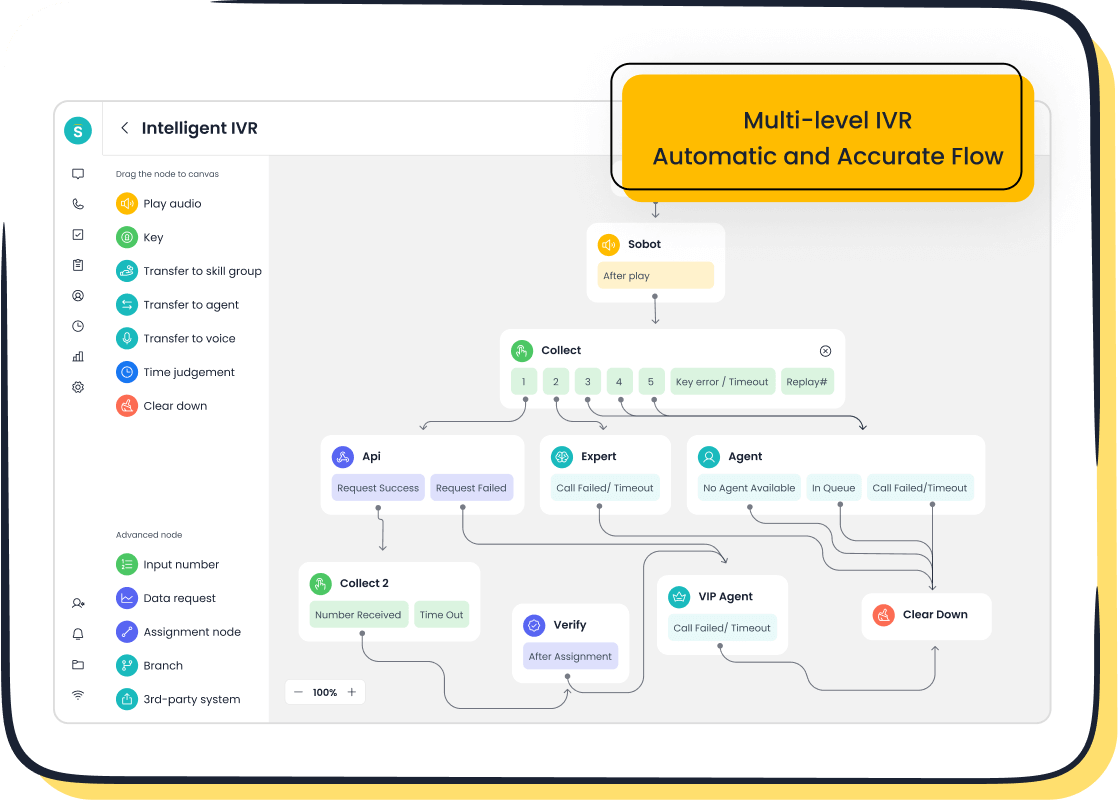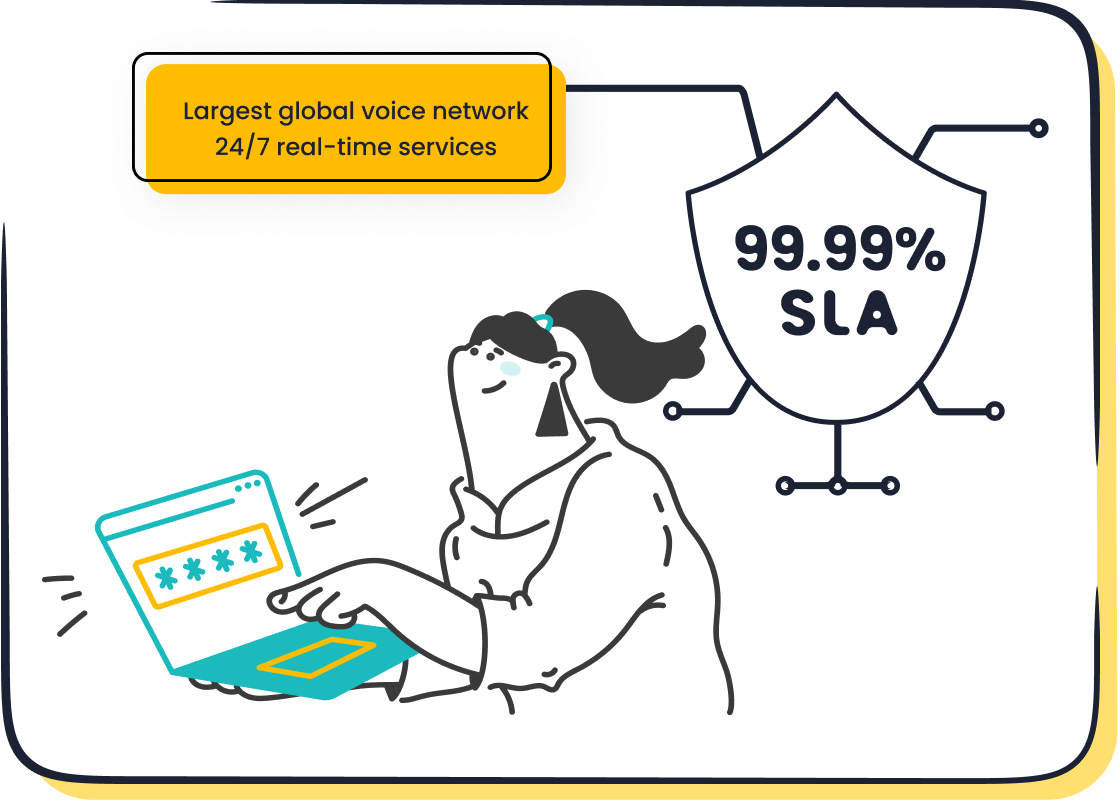What is a Customer Service Knowledge Management System

A customer service knowledge management system serves as a centralized platform that organizes and retrieves essential information. It empowers you to deliver quick and accurate support while maintaining consistency across interactions. Imagine being able to resolve issues faster—73% of customers value speedy resolutions above all else. This system ensures your team has access to the right information, reducing ticket reopens and highlighting gaps in knowledge. By streamlining access to data, tools like Sobot's solutions help you enhance both efficiency and customer satisfaction.
Key Components of a Customer Service Knowledge Management System
Knowledge Base: The Foundation of Customer Service
A knowledge base forms the backbone of any customer service knowledge management system. It acts as a repository of information, offering answers to frequently asked questions, troubleshooting guides, and product details. When customers can access accurate and relevant information quickly, their trust in your brand grows. In fact, 96% of consumers in 2022 reported that they trust brands more when interactions are seamless and straightforward.
For businesses, a well-structured knowledge base reduces the burden on customer service teams. Merchants using automation tools, like those integrated into Sobot's solutions, have seen up to a 60% reduction in support tickets. This efficiency allows agents to focus on complex issues, improving overall service quality. Sobot’s AI-powered Voicebot and Live Chat tools enhance knowledge base accessibility, ensuring customers and agents can retrieve information effortlessly.

Advanced Search Functionality for Quick Access
Search functionality is the engine that powers a knowledge management system. Customers and agents need to locate information quickly, especially during high-pressure situations. Advanced search tools, like those offered by Sobot’s Voice/Call Center, use AI to deliver precise results. These tools analyze keywords, intent, and context to provide the most relevant answers.
Imagine a customer searching for warranty details or troubleshooting steps. Instead of sifting through pages of content, they can find the exact information they need in seconds. This capability not only improves customer satisfaction but also reduces average handle time for agents. By integrating advanced search features, businesses can ensure their knowledge base remains a valuable resource for both internal teams and external users.
Content Management Tools for Seamless Updates
Keeping your knowledge base up-to-date is essential for maintaining accuracy. Content management tools simplify this process by allowing you to edit, organize, and publish information in real time. These tools ensure that outdated content doesn’t hinder your customer service efforts.
Sobot’s solutions, such as its Ticketing System, streamline content updates by automating workflows and providing analytics to identify gaps in knowledge. For example, OPPO, a global smart device leader, optimized its knowledge base with Sobot’s assistance, reducing maintenance efforts by 90%. This efficiency not only saved time but also improved customer satisfaction rates.
Tip: Regularly audit your knowledge base to ensure it aligns with customer needs and business goals. Use analytics to track performance and identify areas for improvement.
| Component | Benefits |
|---|---|
| People | Engagement is crucial; understanding team dynamics and needs enhances effectiveness. |
| Content | Prioritizing and managing content ensures relevance and accessibility, which is vital for users. |
| Technology | Supports KM efforts by providing necessary tools for access, creation, and management of knowledge. |
| Processes | Streamlining existing workflows improves efficiency and effectiveness in knowledge management. |
| Governance | Establishing oversight ensures alignment with goals and monitors the effectiveness of the strategy. |
By leveraging tools like Sobot’s omnichannel solutions, you can ensure your content management processes remain efficient and scalable, even as your business grows.
Analytics and Reporting for Continuous Improvement
Analytics and reporting tools play a vital role in refining your customer service knowledge management system. These tools provide actionable insights that help you identify trends, measure performance, and uncover areas for improvement. By leveraging data, you can make informed decisions that enhance customer interactions and operational efficiency.
For example, tracking response times allows you to evaluate how quickly your team addresses customer inquiries. Monitoring customer satisfaction scores reveals how well your service meets expectations. Additionally, analyzing the number of chats handled by agents helps you assess workload distribution and identify opportunities to optimize team performance.
Pro Tip: Use predictive analytics to anticipate customer needs. This technique enables you to adjust your service proactively, ensuring a seamless experience for your audience.
| Metric/Technique | Description |
|---|---|
| Uncovering Customer Preferences | Analyzes consumer behavior patterns to identify appealing products/services for the target audience. |
| Real-Time Feedback Monitoring | Allows firms to adapt service delivery based on immediate customer satisfaction analysis. |
| Tailored Marketing Strategies | Segments customers for specific marketing messages tailored to their needs. |
| Predictive Analytics | Uses historical data to forecast future customer behaviors, enabling proactive service adjustments. |
| Enhanced Data-Driven Decision-Making | Provides organizations with insights for informed decision-making to improve operations and satisfaction. |

Sobot’s solutions, such as its Voice/Call Center, offer advanced analytics capabilities that empower you to monitor and improve your customer service efforts. With features like real-time call tracking and data analysis, you can uncover valuable insights to enhance your knowledge management system. For instance, OPPO utilized Sobot’s analytics tools to optimize its operations, achieving a chatbot resolution rate of 83% and a positive feedback rate of 94%.
Integration with Tools like Sobot's Voice/Call Center

Integrating your customer service knowledge management system with tools like Sobot’s Voice/Call Center ensures seamless access to information across channels. This integration simplifies workflows, reduces response times, and enhances the overall customer experience.
Sobot’s Voice/Call Center provides features such as intelligent IVR, smart call routing, and AI-powered Voicebot. These capabilities allow you to automate repetitive tasks and focus on resolving complex issues. For example, the intelligent IVR system routes calls to the right agent or team, ensuring customers receive timely and accurate support.
Note: Integration also improves team collaboration. By unifying customer data and communication channels, agents can access relevant information in one workspace, reducing errors and improving efficiency.
The platform’s global number availability and encrypted data transfer further enhance its reliability and security. Whether you’re managing inbound calls or conducting outbound campaigns, Sobot’s Voice/Call Center ensures your customer service operations remain efficient and scalable.
By integrating tools like Sobot’s solutions, you can elevate your customer service knowledge management system to new heights. This approach not only improves operational efficiency but also boosts customer satisfaction and loyalty.
How a Customer Service Knowledge Management System Works
Content Creation and Curation: Building a Reliable Knowledge Base
Creating and curating content is the first step in building a strong customer service knowledge management system. You gather information from multiple sources, such as product manuals, FAQs, and customer feedback. This process ensures that your knowledge base contains accurate and relevant answers to customer queries.
To make this content useful, you need to determine its application and relevance. For example, troubleshooting guides should address common issues, while product details should clarify specifications. Sobot’s AI-powered tools simplify this process by automating the input of Q&A pairs, saving time and reducing manual effort. OPPO, a global smart device leader, used Sobot’s solutions to optimize its knowledge base, cutting maintenance efforts by 90%.
Once the content is ready, sharing it with your team is essential. Training sessions and discussions help employees understand the knowledge base and use it effectively. This collective understanding improves customer service efficiency and ensures consistent responses across channels.
Tip: Regularly update your knowledge base to reflect new products, services, or customer concerns. This keeps your system relevant and reliable.
Organizing Information for Easy Access Across Channels
Organizing information is crucial for ensuring that both customers and agents can find answers quickly. A well-structured system categorizes content into logical sections, such as troubleshooting, billing, or product details. This organization reduces confusion and enhances the user experience.
You can use tools like Sobot’s omnichannel solutions to streamline this process. These tools integrate customer data and communication channels into a unified workspace, making information accessible across platforms like voice, email, and live chat. For instance, Sobot’s Voice/Call Center offers smart call routing and intelligent IVR, ensuring customers are directed to the right resources or agents.
A secure and accessible system also plays a role in effective organization. By structuring knowledge within a centralized platform, you ensure that authorized personnel can retrieve information without delays. This approach minimizes errors and improves response times, especially during high-pressure situations.
Note: Consistent formatting and clear labeling further enhance accessibility. Use tags, filters, and search tools to make navigation intuitive for users.
Retrieving Information Through AI and Search Tools
Retrieving information efficiently is the backbone of a successful customer service knowledge management system. AI-powered search tools analyze keywords, context, and intent to deliver precise results. This capability reduces the time-to-answer (TTA) by up to 30%, compared to traditional systems.
Imagine a customer searching for warranty details. Instead of manually sifting through pages of content, AI tools provide the exact information in seconds. Sobot’s Voice/Call Center leverages AI-driven search functionality to simplify this process. Engineers using similar tools have reported productivity gains, finding necessary data in minutes rather than days.
Advanced search tools also monitor metrics like search accuracy and user satisfaction. Businesses using these tools have seen quantifiable ROI exceeding 300%, with reduced search times and improved customer service efficiency. For example, Accuris saved $7M by cutting research time, while RHC Engineering achieved 150-200% faster RFP responses.
Pro Tip: Use contextual retrieval to anticipate customer needs. This proactive approach enhances satisfaction and builds loyalty.
By integrating AI-powered search tools into your system, you eliminate the need to manually sift through terabytes of data. This efficiency not only saves time but also improves the overall customer experience.
Updating and Maintaining Content for Accuracy
Keeping your customer service knowledge management system accurate and up-to-date is essential for delivering reliable support. Outdated or incorrect information can frustrate customers and reduce their trust in your brand. Regular updates ensure your system remains a valuable resource for both your team and your customers.
Why Accuracy Matters
Accurate content builds trust and improves customer satisfaction. According to a 2023 study, 87% of customers expect companies to provide consistent and reliable information across all channels. When your knowledge base contains errors, it can lead to repeated inquiries, longer resolution times, and dissatisfied customers. For example, if a troubleshooting guide includes outdated steps, customers may struggle to resolve their issues, leading to frustration and negative feedback.
Best Practices for Maintaining Accuracy
-
Schedule Regular Audits
Review your knowledge base periodically to identify outdated or irrelevant content. A quarterly audit works well for most businesses, but high-growth industries may require monthly reviews. Tools like Sobot’s Ticketing System can help you track common customer queries and identify areas needing updates. -
Leverage Analytics
Use analytics to monitor how customers and agents interact with your knowledge base. Metrics like search accuracy and content usage rates reveal which articles need improvement. Sobot’s Voice/Call Center provides real-time data analysis, helping you pinpoint gaps in your system. -
Encourage Feedback
Invite your team and customers to share feedback on the knowledge base. Agents often spot inaccuracies during their daily interactions, while customers can highlight unclear or missing information. For instance, OPPO used Sobot’s solutions to streamline feedback collection, reducing maintenance efforts by 90%. -
Automate Updates
Automation tools simplify the process of updating your knowledge base. Sobot’s AI-powered solutions can automatically suggest edits based on new customer inquiries or product changes. This feature saves time and ensures your content stays relevant. -
Train Your Team
Educate your team on the importance of maintaining accuracy. Provide training sessions on how to update the knowledge base and use analytics tools effectively. A well-trained team ensures your system continues to meet customer needs.
Real-World Example: OPPO’s Success
OPPO, a global leader in smart devices, faced challenges in maintaining its extensive knowledge base. By partnering with Sobot, OPPO automated the input of Q&A pairs and integrated analytics tools to monitor content performance. These efforts reduced manual maintenance by 90% and improved customer satisfaction rates. This example highlights the importance of using advanced tools to keep improving a customer service knowledge management system.
Tip: Always align your updates with customer feedback and business goals. This approach ensures your system remains both accurate and effective.
By following these practices and leveraging tools like Sobot’s solutions, you can maintain a knowledge base that consistently meets customer expectations. Regular updates not only improve accuracy but also enhance the overall efficiency of your customer service operations.
Benefits of a Customer Service Knowledge Management System

Faster Issue Resolution and Improved Efficiency
A customer service knowledge management system significantly reduces the time it takes to resolve customer issues. By providing immediate access to a centralized database, customer service agents can quickly retrieve accurate information. This efficiency minimizes wait times and enhances the overall customer experience.
- Self-service options resolve approximately 54% of customer issues, showcasing the potential of well-organized knowledge management systems.
- Centralized resources allow agents to handle inquiries more swiftly, improving operational efficiency.
| Statistic | Description |
|---|---|
| 54% | Self-service resolves around 54% of customer issues with better resources. |

Sobot’s Voice/Call Center exemplifies this benefit. Its intelligent IVR and AI-powered Voicebot streamline workflows, enabling agents to focus on complex problems. These tools not only improve resolution times but also enhance the productivity of your customer service team.
Tip: Equip your agents with tools that integrate seamlessly with your knowledge base to maximize efficiency.
Enhanced Customer Satisfaction and Loyalty
When customers receive fast and accurate support, their satisfaction and loyalty increase. A knowledge management system ensures consistent responses across all channels, building trust in your brand. Metrics like customer satisfaction scores and Net Promoter Scores (NPS) reflect this improvement.
| Metric | Description |
|---|---|
| Customer Satisfaction Scores | Reflects overall satisfaction with the brand. |
| Likelihood of Repurchase | Indicates the probability of customers buying again. |
| Net Promoter Score (NPS) | Measures the likelihood of recommending the brand to others. |
Sobot’s omnichannel solutions unify customer interactions, ensuring seamless experiences across platforms. For example, OPPO achieved a 94% positive feedback rate and a 57% increase in repurchase rates by optimizing its knowledge base with Sobot’s tools.
Note: Consistency in service delivery fosters loyalty and encourages repeat business.
Streamlined Team Collaboration and Training
A centralized knowledge management system simplifies collaboration among customer service agents. Teams can access shared resources, reducing duplication of effort and improving communication. This system also accelerates training for new agents by providing them with a comprehensive repository of information.
Sobot’s unified workspace consolidates customer data and communication channels, making it easier for teams to work together. Features like real-time analytics and smart call routing ensure agents stay informed and aligned. By streamlining workflows, your team can focus on delivering exceptional customer service.
Pro Tip: Use analytics to identify knowledge gaps and improve training materials for your team.
Cost Savings and Operational Scalability
A customer service knowledge management system helps you save costs while scaling your operations efficiently. By centralizing information, you reduce the time agents spend searching for answers. This efficiency lowers operational expenses and improves productivity. For example, self-service options like FAQs and chatbots resolve 54% of customer issues without agent involvement. This reduces the need for additional staff during peak periods.
Sobot’s solutions, such as its AI-powered Voice/Call Center, enhance cost savings by automating repetitive tasks. Features like intelligent IVR and smart call routing ensure customers reach the right agent quickly, minimizing call durations. Businesses using Sobot’s tools report significant reductions in inbound discussion volumes, with some achieving a 20% decrease. These savings allow you to allocate resources to other critical areas, such as training or product development.
Scalability becomes seamless with a robust system in place. As your business grows, the system adapts to handle increased customer service demands. Sobot’s global network and 99.99% system uptime ensure uninterrupted service, even during high-traffic periods. Whether you’re managing a small team or a global operation, Sobot’s solutions provide the flexibility and reliability you need to scale effectively.
Tip: Invest in tools that combine automation with scalability. This approach ensures your customer service operations remain cost-effective and future-ready.
Real-World Success: Sobot's Role in Optimizing Knowledge Management
Sobot has helped businesses worldwide achieve measurable success in customer service through optimized knowledge management. Companies using Sobot’s solutions report improved efficiency, higher satisfaction rates, and better problem resolution.
| Metric | Result |
|---|---|
| Reduced inbound discussion volume | 20% |
| Increased positive feedback | 96% + |
| Correct answers | Over 80% |
| Customer satisfaction | Over 95% |
| Self-service question resolution | 22.2% |
| CSAT score | 97% |
| Problem resolution rate | 85% |
| Customer happiness | 99% |
| Sign-off rate | Increased by 35% |
| COD collection rate | Increased by 40% |
For instance, OPPO, a global leader in smart devices, partnered with Sobot to streamline its knowledge base. By automating Q&A input and integrating customer channels, OPPO reduced maintenance efforts by 90%. This optimization led to an 83% chatbot resolution rate and a 94% positive feedback rate. These results demonstrate how Sobot’s tools transform customer service operations, delivering both efficiency and satisfaction.
Note: Real-world examples like OPPO highlight the importance of investing in advanced knowledge management systems. They show how you can achieve similar success by leveraging the right tools.
Steps to Implement a Successful Customer Service Knowledge Management System

Assessing Business Needs and Goals
Before implementing a customer service knowledge management system, you need to evaluate your business needs and align them with your goals. This step ensures that your investment delivers measurable results. Start by identifying the challenges your team faces, such as inconsistent information or slow response times. Then, determine how a knowledge management system can address these issues.
Uncovering skills and performance gaps early is essential. A PWC study revealed that only 40% of employers actively upskill their workers, leaving many teams unprepared for evolving customer demands. By addressing these gaps, you can improve efficiency and reduce employee frustration. Aligning training with your business objectives ensures that every effort contributes to achieving your goals. For example, prioritizing training on tools like Sobot’s Voice/Call Center can help your team handle inquiries more effectively.
Tip: Regularly review your goals to ensure they remain relevant as your business grows.
Choosing the Right Tools, Including Sobot's Solutions
Selecting the right tools is critical for building a successful system. Look for solutions that integrate seamlessly with your existing infrastructure and offer features tailored to your needs. Sobot’s omnichannel solutions provide a unified workspace, AI-powered automation, and real-time analytics, making them ideal for enhancing customer service operations.
For instance, Sobot’s Voice/Call Center includes intelligent IVR and smart call routing, which streamline workflows and reduce response times. These tools ensure that your team can access accurate information quickly, improving both efficiency and customer satisfaction. Additionally, Sobot’s global network and 99.99% uptime guarantee reliable performance, even during peak periods.
Note: Choose tools that offer scalability to support your business as it grows.
Developing a Comprehensive Content Strategy
A strong content strategy ensures your knowledge base remains accurate and engaging. Start by tracking engagement metrics like likes, shares, and comments to understand what resonates with your audience. Adjust your content based on these insights to keep it relevant.
Breaking down silos between departments is another key step. A centralized system, like Sobot’s omnichannel platform, integrates real-time data from various sources, ensuring all teams work with the same information. Shared dashboards and cross-departmental KPIs further enhance collaboration, helping you align your content with customer needs.
| Strategy | Description |
|---|---|
| Real-time data integration | Links various data sources for immediate access to current information. |
| Cross-functional collaboration | Encourages teams to share insights and align on goals. |
| Shared dashboards | Displays customer interactions and KPIs for unified performance tracking. |
Pro Tip: Regularly analyze your content’s performance to ensure it aligns with customer expectations and business objectives.
Training Teams for Effective System Use
Training your team is essential for maximizing the potential of a customer service knowledge management system. A well-trained team ensures consistent and efficient use of the system, leading to better customer interactions. Start by introducing your team to the system’s features and functionalities. For example, demonstrate how to use advanced search tools or update the knowledge base. Hands-on training sessions help agents feel confident and prepared.
Provide role-specific training to address the unique needs of your team. For instance, customer service agents may need to focus on retrieving information quickly, while managers might prioritize analytics and reporting tools. Sobot’s Voice/Call Center simplifies this process by offering a unified workspace where agents can access customer data and communication tools in one place. This integration reduces the learning curve and enhances productivity.
Encourage continuous learning by offering refresher courses and access to training materials. Use real-world scenarios to simulate customer interactions, helping agents apply their knowledge effectively. For example, OPPO improved its customer service efficiency by training its team to use Sobot’s AI-powered tools, achieving an 83% chatbot resolution rate.
Tip: Use analytics to identify areas where your team may need additional training. This proactive approach ensures your team stays ahead of customer expectations.
Monitoring and Regularly Updating the System
Monitoring and updating your customer service knowledge management system is crucial for maintaining its effectiveness. Regular audits help identify outdated content and ensure the system aligns with customer needs. For example, review frequently accessed articles to confirm their accuracy and relevance.
Leverage analytics tools to track system performance. Metrics like search accuracy, response times, and customer satisfaction scores provide valuable insights. Sobot’s solutions, such as its Ticketing System, offer real-time data analysis, helping you pinpoint areas for improvement. For instance, OPPO reduced maintenance efforts by 90% by using Sobot’s analytics to optimize its knowledge base.
Encourage feedback from both agents and customers to identify gaps in the system. Agents often encounter issues during daily interactions, while customers can highlight unclear or missing information. Use this feedback to make targeted updates, ensuring the system remains a reliable resource.
Pro Tip: Automate updates where possible. Sobot’s AI-powered tools can suggest edits based on new customer inquiries, saving time and improving accuracy.
By monitoring and updating your system regularly, you ensure it continues to meet the evolving needs of your business and customers. This proactive approach enhances customer service efficiency and satisfaction.
Best Practices for Maintaining a Knowledge Management System
Regular Content Audits and Updates
Regular audits ensure your knowledge management system stays accurate and relevant. Outdated information can frustrate customers and reduce trust in your customer service. By scheduling periodic reviews, you can identify gaps, remove irrelevant content, and update articles to reflect current products or policies. For example, a quarterly audit might reveal that a troubleshooting guide no longer applies to a discontinued product.
Monitoring key metrics like ticket volume and resolution rates helps you prioritize updates. If a specific article receives frequent views but low satisfaction ratings, it may need improvement. Tools like Sobot’s analytics features simplify this process by highlighting performance trends and inefficiencies. These insights allow you to implement corrective actions that improve customer interactions.
Tip: Automate reminders for audits to ensure consistency. Sobot’s AI-powered tools can even suggest updates based on new customer inquiries, saving time and effort.
Encouraging Feedback from Agents and Customers
Feedback is a powerful tool for maintaining a high-performing knowledge management system. Agents often encounter issues during daily interactions, making them valuable contributors to system improvements. Encourage them to report unclear or missing information. Similarly, customers can provide insights into how well the system meets their needs.
For example, a customer might flag an article as confusing, prompting you to revise it for clarity. Sobot’s omnichannel solutions make it easy to collect feedback across platforms like live chat, email, and voice. By analyzing this input, you can identify root causes of inefficiencies and enhance the overall customer experience.
Pro Tip: Create a simple feedback form for agents and customers to share their thoughts. Use this data to make targeted updates that align with user expectations.
Ensuring Consistent Formatting and Quality Standards
Consistency in formatting and quality ensures your knowledge base remains user-friendly. Clear headings, concise language, and logical organization make it easier for users to find information. For instance, using bullet points for step-by-step guides improves readability.
Implementing quality assurance processes helps maintain these standards. Regularly review articles to ensure they meet your guidelines. Sobot’s unified workspace allows teams to collaborate on content updates, ensuring consistency across all channels. Tracking metrics like response time and customer satisfaction scores also helps you measure the effectiveness of your system.
Note: Standardized templates for articles can streamline content creation and ensure uniformity.
By following these best practices, you can maintain a knowledge management system that supports efficient and reliable customer service. Regular updates, user feedback, and consistent formatting create a resource that benefits both your team and your customers.
Leveraging Analytics to Identify Knowledge Gaps
Analytics plays a crucial role in identifying knowledge gaps within your customer service system. By analyzing data, you can uncover areas where your knowledge base falls short, leading to better decision-making and improved service quality. For example, tracking metrics like search accuracy and article usage rates helps you pinpoint which content needs updates or additional details.
Benchmarking is another effective way to identify gaps. Comparing your performance metrics against industry leaders reveals areas for improvement. For instance:
- Benchmarking analysis highlights performance gaps by comparing your metrics to top-performing companies.
- Collecting and analyzing data uncovers insights that drive continuous improvement.
- Real-world examples show that businesses using benchmarking have enhanced efficiency and customer satisfaction.
Sobot’s solutions, such as its Voice/Call Center, provide advanced analytics tools that simplify this process. These tools track customer interactions, monitor response times, and analyze feedback. For example, OPPO used Sobot’s analytics to optimize its knowledge base, achieving a chatbot resolution rate of 83%.
Tip: Use predictive analytics to anticipate customer needs. This proactive approach ensures your knowledge base evolves with customer expectations.
Integrating with Omnichannel Solutions like Sobot
Integrating your knowledge management system with omnichannel solutions ensures seamless customer service across all platforms. Customers today expect consistent experiences, whether they contact you via email, live chat, or phone. A unified system ensures your team has access to the same information, reducing errors and improving efficiency.
Sobot’s omnichannel solutions excel in this area. They consolidate customer interactions into a single workspace, making it easier for agents to retrieve information and provide accurate support. Features like AI-driven chatbots and smart call routing enhance the customer experience by automating repetitive tasks and directing inquiries to the right channels.

For example, Sobot’s Voice/Call Center integrates with your knowledge base to provide real-time access to information during calls. This integration reduces average handle time and improves first-contact resolution rates. Businesses using Sobot’s tools report increased customer satisfaction and loyalty, as seamless service builds trust and encourages repeat interactions.
Note: Integration also supports scalability. As your business grows, Sobot’s solutions adapt to handle higher volumes of customer inquiries without compromising service quality.
A customer service knowledge management system plays a vital role in improving efficiency, customer satisfaction, and scalability. It ensures your team delivers consistent and accurate support, which builds trust and loyalty. Successful customer service knowledge management systems empower you to resolve issues faster and enhance operational workflows. For example, tools like Sobot’s Voice/Call Center integrate advanced features such as intelligent IVR and AI-powered Voicebot. These solutions streamline processes, reduce response times, and improve the overall customer experience. The importance of customer service knowledge management cannot be overstated—it is the foundation for delivering exceptional service and achieving long-term success.
FAQ
What is a customer service knowledge management system?
A customer service knowledge management system is a centralized platform that organizes and retrieves information. It helps you provide accurate, consistent, and fast support. Tools like Sobot’s Voice/Call Center integrate advanced features, ensuring seamless access to data for both agents and customers.
How does a knowledge management system improve customer service?
It reduces response times by providing quick access to accurate information. For example, Sobot’s AI-powered tools streamline workflows, enabling agents to resolve issues faster. This efficiency enhances customer satisfaction and builds trust in your brand.
Can small businesses benefit from a knowledge management system?
Yes, small businesses can use it to improve efficiency and reduce costs. Sobot’s solutions, like its Ticketing System, automate workflows and simplify content updates, making it easier for smaller teams to manage customer inquiries effectively.
How does Sobot enhance knowledge management systems?
Sobot integrates AI-driven tools like intelligent IVR and Voicebot into its solutions. These features automate repetitive tasks, improve search accuracy, and provide real-time analytics. Businesses like OPPO have achieved significant efficiency gains using Sobot’s tools.
Why is updating a knowledge management system important?
Regular updates ensure your system remains accurate and reliable. Outdated information can frustrate customers. Sobot’s analytics tools help you identify gaps and automate updates, keeping your knowledge base aligned with customer needs.
See Also
The Ultimate List of Customer Service Software for 2024
Essential QMS Principles Every Call Center Should Follow
Ten Key Considerations for Selecting Social Media Support Tools
Effective Strategies for Quality Management in Call Centers
Transforming Customer Support with AI-Powered Service Agents
